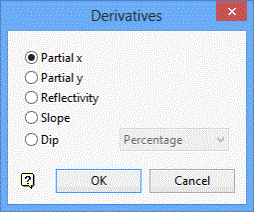Derivatives
Use the Derivatives option to obtain various first order derivatives by differentiating the spline surface patches.
For example, if you want to find the path of least resistance up a hill, you can calculate the slope (derivative) grid from the topography grid to determine the areas of lesser slope.
Instructions
On the Grid Calc menu, point to Model, and then click Derivatives to display the Derivatives panel.

Partial X
Select this option to calculate partial derivatives with respect to X. This will highlight North-South features.
Partial Y
Select this option to calculate partial derivatives with respect to Y. This will highlight East-West features.
Reflectivity
Select this option to calculate reflectivity. This is related to the derivatives by the formula (1+(δx)²+(δy)²)-0.5and corresponds to the cosine of the angle between a vertical ray and the surface normal. Hence, flat surfaces yield a reflectivity of one, while vertical surfaces (not possible with the spline patch) yield a reflectivity of zero.
Slope
This is related to the derivatives by the formula ((δx)²+(δy )²)0.5. Although the slope is related to the angle of dip, it is not a simple formula. The slope is the length of the (X, Y) component of the un-normalised surface normal. The steeper the slope, the greater the 'slope' value. Slope can be used to highlight discontinuities in the surface such as faults.
Dip
Select this option to generate dip grids. The resulting dip grids can be produced in radians, degrees and percent.
Reflectivity applied to a Slope map will greatly enhance discontinuities, but will also highlight every unwanted feature of a grid - such as those flaws produced by a particular gridding method. Beware of fabricating surface features.
Click OK.
The derivatives are calculated. If you chose to display the grid dynamically, then the grid is updated automatically. If you did not display the grid dynamically, redisplay the grid using the Static Display Grid option.

